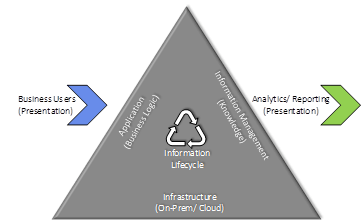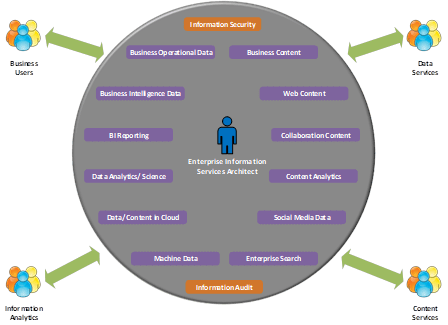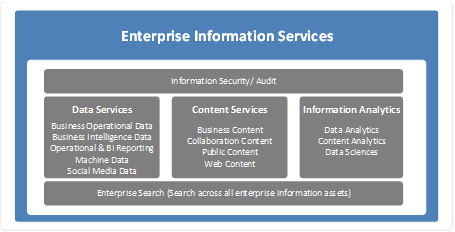Introduction
In today’s world, data is considered the new gold. Every enterprise is in a rush to gather as much data as possible. Data is being monetized and taken care of more than ever. Enterprises are working hard to make sure they can capture this data and manage it efficiently over its lifecycle. In most organizations, the way data is managed is in three different ways. Data Custodians will be the owner of the data, and DBAs take care of business/ OLTP data daily. DW/BI team takes care of OLAP and Reporting requirements of the organizations so that intelligence can be derived from the data captured and business decisions can be made. Apart from the structured data, enterprises also generate and get a lot of content (documents or Media) these days. Most organizations have Enterprise Content Management teams that manage content throughout its lifecycle. These departments are focused on what they do and have cadence between these departments and application delivery groups.
Challenge
Today's demands to manage data generated in the enterprise are far more than what DBAs & Content Management teams manage. We need to identify how we get data and where it is stored. We should also know which data is of value and which is not. The data team will not look at anything stored outside of RDBMS, and ECM Team will not look at Content residing outside of ECM Repositories. This document will discuss how this information management style can be changed to fulfill today's needs. One overarching information management will help in streamlining information management and reducing gaps from the DIKAR model.
The author recognizes that some organizations have already matured and have implemented the suggested solution.
Managing Information
First and foremost, enterprises need to track all types of data that they receive. We need to make sure that we know the entry point, nature of data, where it gets stored, its value, and its retention. In addition, with all the data privacy laws, the enterprise needs to make sure that data is not only secured, but if there is any data breach, it should be informed to its customers.
Information Lifecycle
Information gathered by an enterprise needs to be managed throughout its lifecycle. Enterprise receives data either directly from business users or business applications which hold business logic. Data is first captured, stored, and managed with the appropriate security in enterprise infrastructure. It can be stored on-premises or in the cloud. From the data received from multiple sources information and knowledge can be derived, which can help in making business decisions that add value. This process of harnessing knowledge and value from data is information management and can be presented in the forms of analytics and reporting.
Wholistic Information Management
Organizations can have structured, unstructured, and semi-structured data from different sources. Data can be received from OLTP, OLAP, social media, or directly from machines. Enterprises today store their data in the cloud and harness knowledge from social media too. Below are some types of data that organizations receive today. Different teams can manage such a set of data. Apart from the data we receive and have in the organization, we need to have security on it based on its data classification and audit on a timely basis so that organizations stay in compliance. Although all these teams can be custodians of their data, Enterprise Information Architect can be the one who can define and create guidelines on how each set of data needs to be maintained/ stored over its lifecycle.
Business users can contact Enterprise Information Services Architect (EISA) about the new requirement for the data that needs to be stored or will be coming to an organization due to having a new application. EISA can track any data (structured and unstructured) and make sure it is aligned with the enterprise data/ information guidelines. EISA can then directly coordinate with the Enterprise Information Service management team so that teams can manage data.
Enterprise can create an Enterprise Information Services department that can have three significant teams –
- Data Services can handle operations, BI, reporting, machine, and social media data.
- Content services can handle business, collaboration, public, and web content.
- Information Analytics can handle data & content analytics. Data science can also be part of it.
- All type of data needs to follow security, IT audit, and compliance guidelines. IT Security usually provides guidelines for data classification and controls to be put in place to secure a higher value data set.
One more functionality any Information Services should provide is Enterprise Search. There should be a way to search all the data that enterprises store.
Conclusion
All the data that enterprises receive can be classified into three primary Information Services – Data Services, Content Services, and Information Analytics- converting this data into knowledge and adding value to the enterprise. There is no use of data if it is there but cannot be searched as a value out of it cannot be derived, and the only cost will be incurred. So, findability and Enterprise Search are essential. Furthermore, since enterprises store customers' data, enterprises need to have the type of security data demands. Data need to be more secure if the data is restricted and less if it is public.
Data is said to be the new gold and needs to be managed and protected accordingly. Enterprise use of data can be either for tactical use or strategical use. So, Data can serve as a service to business stakeholders to gain maximum value from knowledge stored.









